Possible Mechanism for the Tsunami-Related Fires That Occurred at Aonae Harbor on Okushiri Island in the 1993 Hokkaido Nansei-Oki Earthquake
Abstract
1. Introduction
2. Materials and Method
2.1. Materials for Spatio-Temporal Events Study
2.2. Laboratory Experiments
3. Results and Discussion
3.1. Spatio-Temporal Survey of the Events Leading to the Tsunami Fires
3.2. Working Hypothesis: Modeling the Tsunami Fires
3.3. Where Did Methane Release?
3.4. How Were Methane Bubbles Carried to the Coastal Area?
3.5. How Did the Methane Bubbles Ignite?
4. Concluding Remarks
Author Contributions
Acknowledgments
Conflicts of Interest
Appendix A
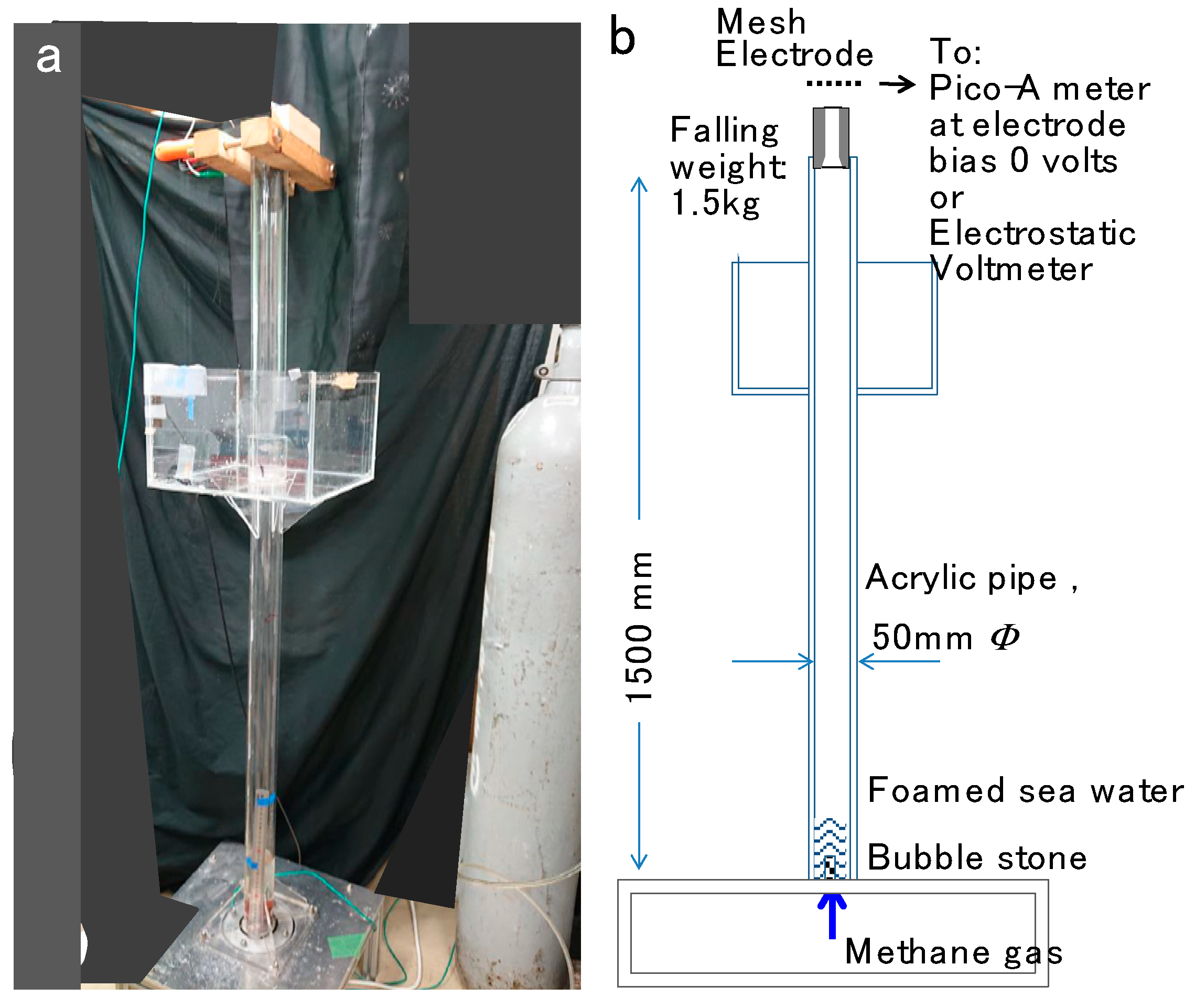
Appendix B
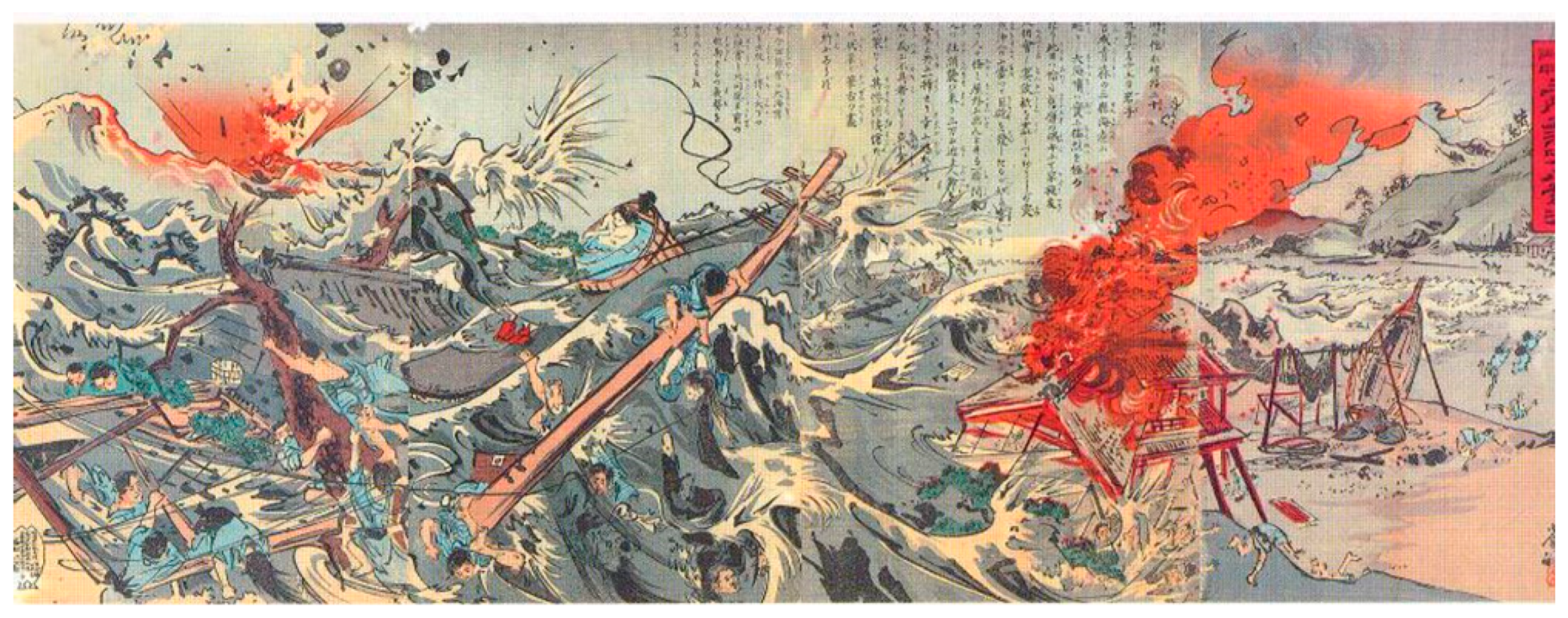
References
- Hiyama Fire Department, Okushiri Fire Station. Heisei 5nen Hokkaido Nansei-Oki Jisin Tyousahoukokusho; Self Publishing: Okushiri, Japan, 1993; p. 56. (In Japanese) [Google Scholar]
- Bernard, E.N.; Gonzalez, F.I. Tsunami runup distribution generated by the July 12, 1993, Hokkaido Nansei-Oki earthquake. In Wind and Seismic Effects. Proceedings of the 26th Joint Meeting; U.S. Dept. of Commerce, National Institute of Standards and Technology: Gaithersburg, MD, USA, 1994; NIST SP871; pp. 335–343. [Google Scholar]
- Shuto, N.; Matsutomi, H. Field survey of the 1993 Hokkaido Nansei-Oki earthquake tsunami. Pure Appl. Geophys. 1995, 144, 649–663. [Google Scholar] [CrossRef]
- Satake, K.; Tanioka, Y. Tsunami generation of the 1993 Hokkaido Nansei-Oki earthquake. Pure Appl. Geophys. 1995, 145, 803–821. [Google Scholar] [CrossRef]
- Takahashi, T.; Takahashi, T.; Shuto, N.; Imamura, F.; Ortiz, M. Source models for the 1993 Hokkaido Nansei-Oki earthquake tsunami. Pure Appl. Geophys. 1995, 144, 748–766. [Google Scholar] [CrossRef]
- Okushiri-cho. Hokkaido Nansei-Oki Jisin Okushiri-Cho Kirokusho; Hirakawa Shuppan-sha: Okushiri, Japan, 1996; p. 255. (In Japanese) [Google Scholar]
- Japan Society of Civil Engineers (JSCE). Fires. In Reconnaissance Report on the July 12, 1993 Hokkaido Nansei-Oki Earthquake; Taishin-kogaku, I., Ed.; JSCE: Tokyo, Japan, 1997. Chapter 13. (In Japanese) [Google Scholar]
- Sekizawa, A.; Sasaki, K. Study on Fires Following the 2011 Great East-Japan Earthquake based on the Questionnaire Survey to Fire Departments in Affected Areas. Fire Saf. Sci. 2014, 11, 691–703. [Google Scholar] [CrossRef]
- Hiroi, U. Questionnaire survey about the great East-Japan earthquake and estimation method concern on tsunami-fire. J. Soc. Saf. Sci. 2014, 24, 1–11. (In Japanese) [Google Scholar]
- Yamada, T.; Hiroi, U.; Sakamoto, N. Aspects of fire occurrences caused by tsunami. Fire Sci. Technol. 2011, 30, 101–115. [Google Scholar] [CrossRef][Green Version]
- Hokugo, A.; Nishino, T.; Inada, T. Tsunami fires after the great east Japan earthquake. J. Disaster Res. 2013, 8, 584–593. [Google Scholar] [CrossRef]
- Nishino, T.; Imazu, Y. A Computational Model for Large-Scale Oil Spill Fires on Water in Tsunamis: Simulation of Oil Spill Fires at Kesennuma Bay in the 2011 Great East Japan Earthquake and Tsunami. J. Loss Prev. Process Ind. 2018, 54, 37–48. [Google Scholar] [CrossRef]
- The Japan Association for Fire Science and Engineering. 2011nen, Higashi-Nihon Daisinsai Kasai-tò Tyòsa Hòkokusyo [Yòyaku-ban]; Sansyu-sha: Tokyo, Japan, 2015; p. 300. (In Japanese) [Google Scholar]
- Enomoto, Y.; Yamabe, T.; Kondo, H. Why did the tsunami fires occur at Aonae district of Okushiri Island in the 1993 Hokkaido-Nansei-Oki earthquake? -Examination of eyewitness testimonies/NHK TV video and discussion on the plausible explanation for the ignition mechanism. Hist. Earthq. 2019, 34. in press. (In Japanese) [Google Scholar]
- Izawa, Y. Tsunami Niyoru Syaryoukasai Nikansuru Kenkyuu (II) (Study on Vehicle Fires due to Tsunami). Annu. Rep. Shobo-Kenkyu Shitsu City Nagoya 2013, 42, 18–23. (In Japanese) [Google Scholar]
- Okano, H.; Fujioka, K.; Tanaka, T.; Takeuchi, A.; Kuramoto, S.; Tokuyama, H.; Soh, W.; Kato, S. Seismo-induced fissure, liquefaction, and other microtopography caused by the Hokkaido Nansei-Oki earthquake of July 12, 1993 at Okushiri ridge Japan sea, Japan. JAMSTEC J. Deep Sea Res. 1995, 11, 381–398. [Google Scholar]
- Leifer, I.; Patro, R.K. The bubble mechanism for methane transport from the shallow sea bed to the surface: A review and sensitivity study. Cont. Shelf Res. 2002, 22, 2400–2428. [Google Scholar] [CrossRef]
- Xu, Y.; Wang, L.; Liang, D.; Yu, M.; Chu, T. Experimental and mechanism study of electrically charged water mist for controlling kerosene fire in a confined space. Proced. Eng. 2014, 71, 246–252. [Google Scholar] [CrossRef]
- Best, A.I.; Richardson, M.D.; Boudreau, B.P.; Judo, A.G.; Leifer, I.; Lyons, A.P.; Martens, C.S.; Orange, D.L.; Wheeler, S.J. Shallow seabed methane gas could pose coastal hazard. EOS 2006, 87, 213–220. [Google Scholar] [CrossRef]
- Goddin, O.A. Air-sea interaction and feasibility of tsunami detection in the open ocean. J. Geophys. Res. 2004, 109, C05002. [Google Scholar] [CrossRef]
- Pratt, T.H. Electrostatic Ignitions of Fires and Explosions; Center for Chemical Process Safety of the American Institute of Chemical Engineers: New York, NY, USA, 2000; p. 182. [Google Scholar]
- Bhattacharyya, I.; Maze, J.T.; Ewing, G.E.; Jarrold, M.F. Charge separation from the bursting of bubbles on water. J. Phys. Chem. 2011, 115, 5723–5728. [Google Scholar] [CrossRef]
- Blanchard, D.C. The electrification of the atmosphere by particles from bubbles in the sea. Prog. Oceanogr. 1963, 1, 71–202. [Google Scholar] [CrossRef]
- Chubb, J.N. Practical and computer assessments of ignition hazards during tank washing and during wave action in part-ballasted obo cargo tanks. J. Electrost. 1975, 1, 61–70. [Google Scholar] [CrossRef]
- Matsubara, Y. Risk assessment of explosions and fires caused by static electricity. J. Inst. Electrost. Jpn. 2001, 25, 77–82. (In Japanese) [Google Scholar]
- Choi, K.S.; Yamaguma, M.; Osawa, A. Characteristics of ignitability of sprayed liquids due to electrostatic spark (I). Specif. Res. Rep. Nati. Inst. Occup. Saf. Health JNIOSH-SPR 2008, 38, 23–29. (In Japanese) [Google Scholar]
- Mittal, M.; Guha, B.K. Industrial fires and explosions due to electerostatic ignition. Chem. Eng. Technol. 1993, 16, 325–331. [Google Scholar] [CrossRef]
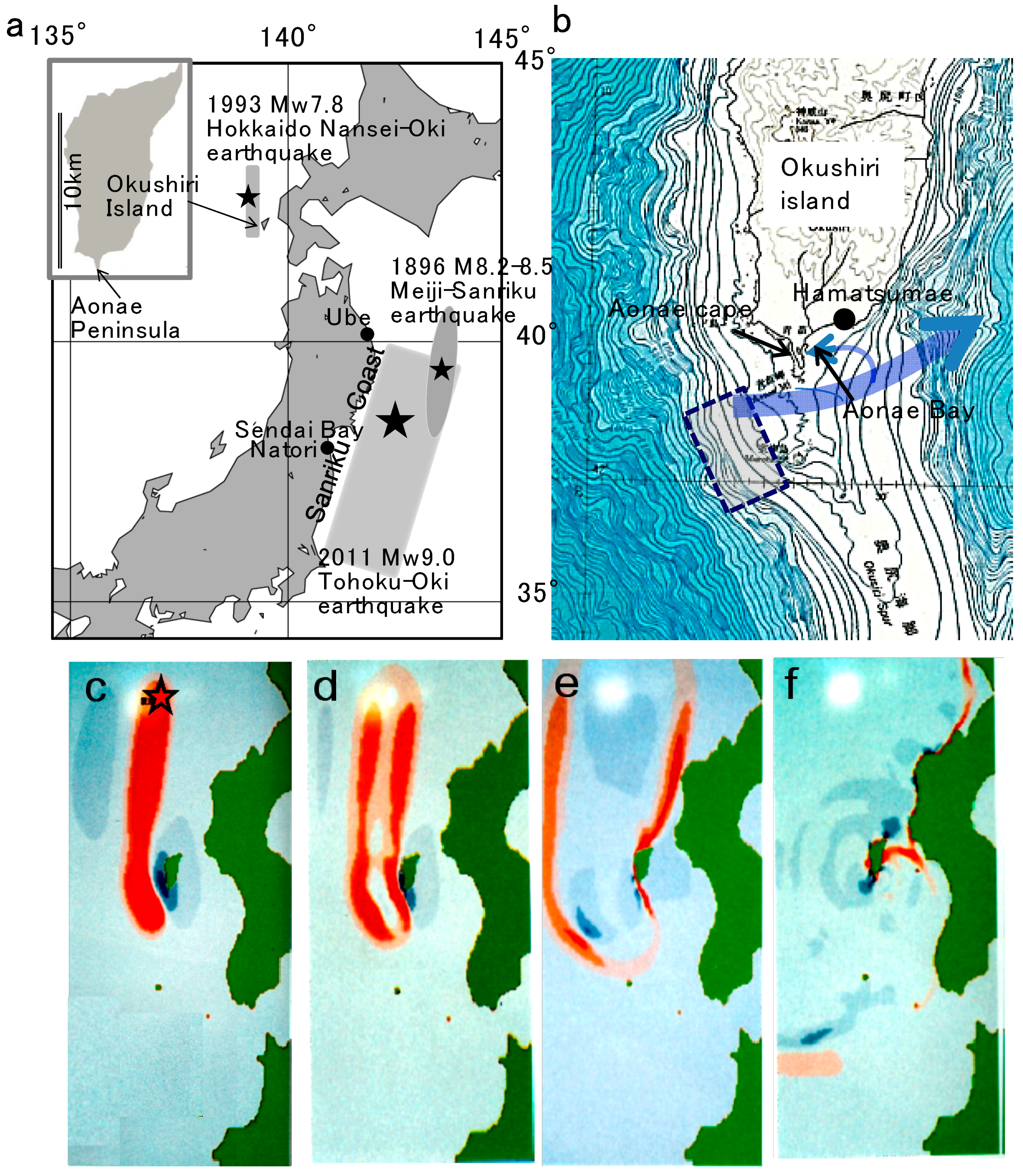
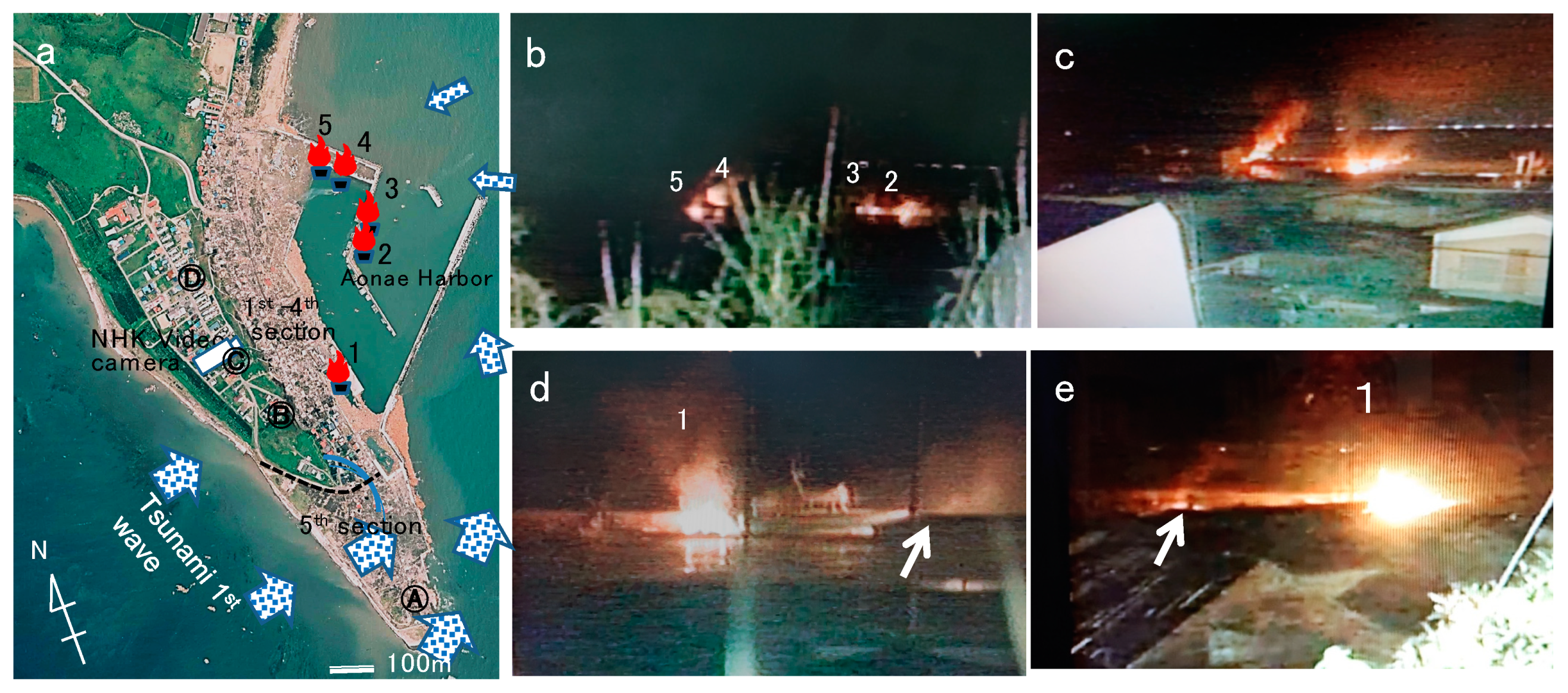
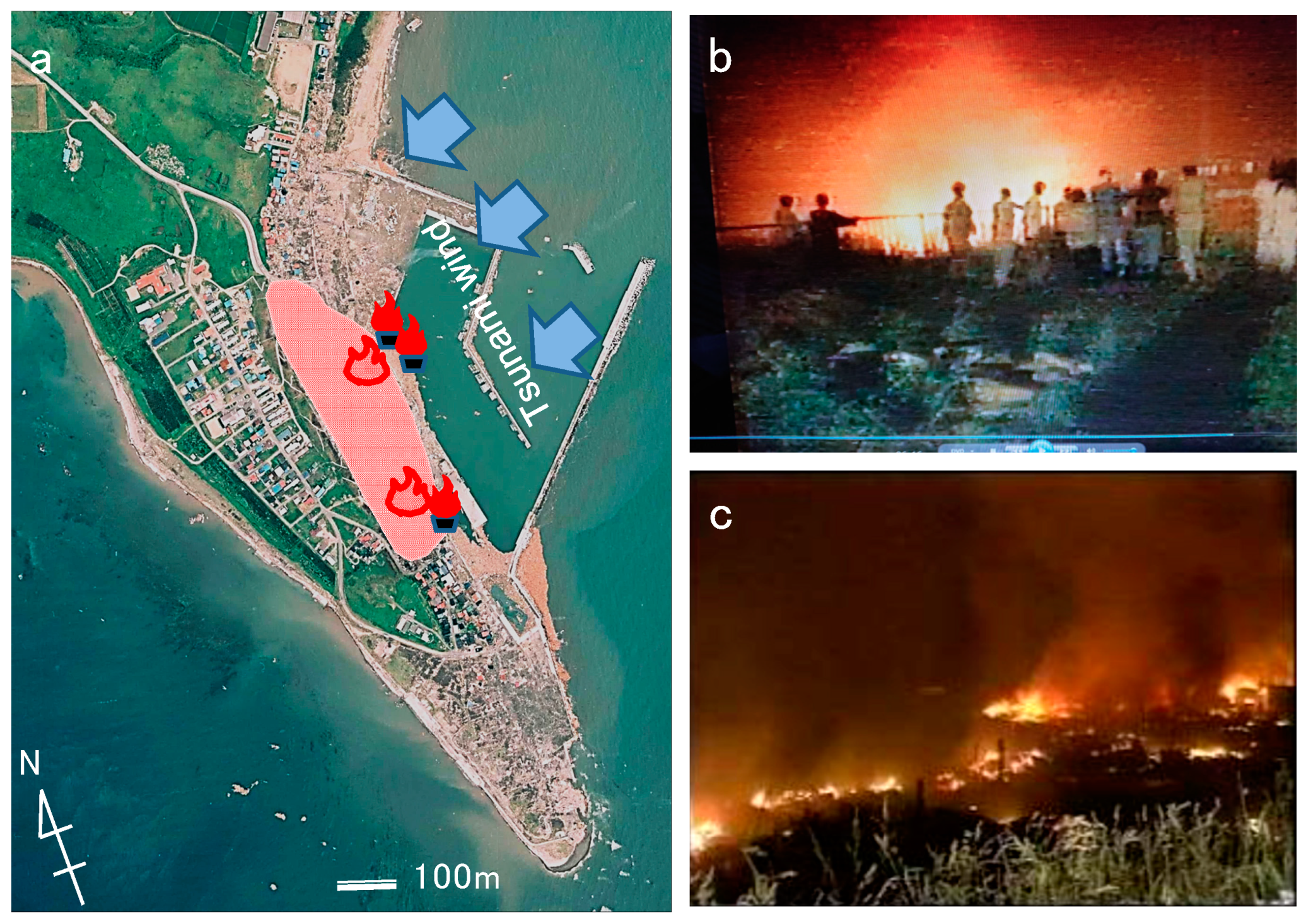
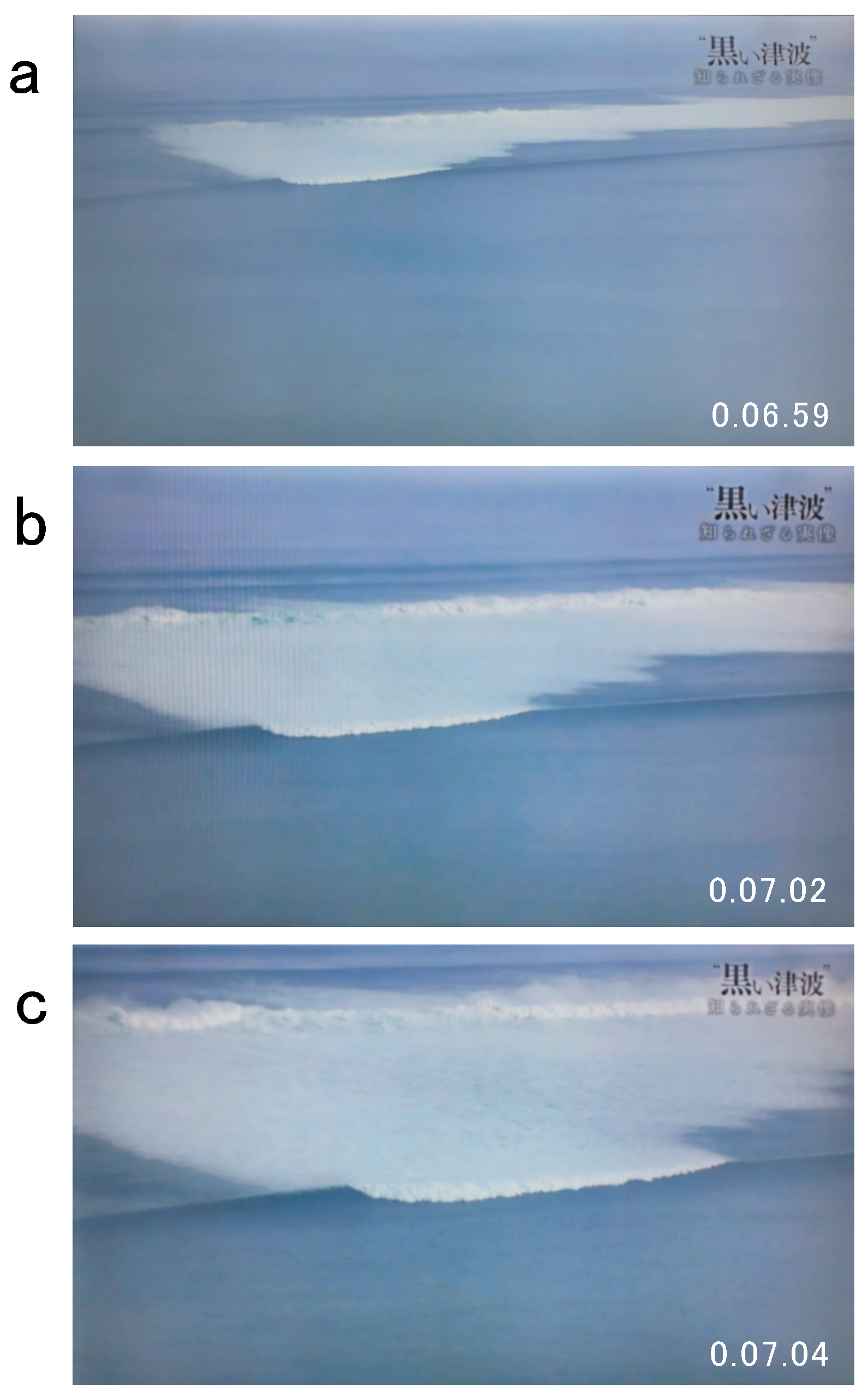
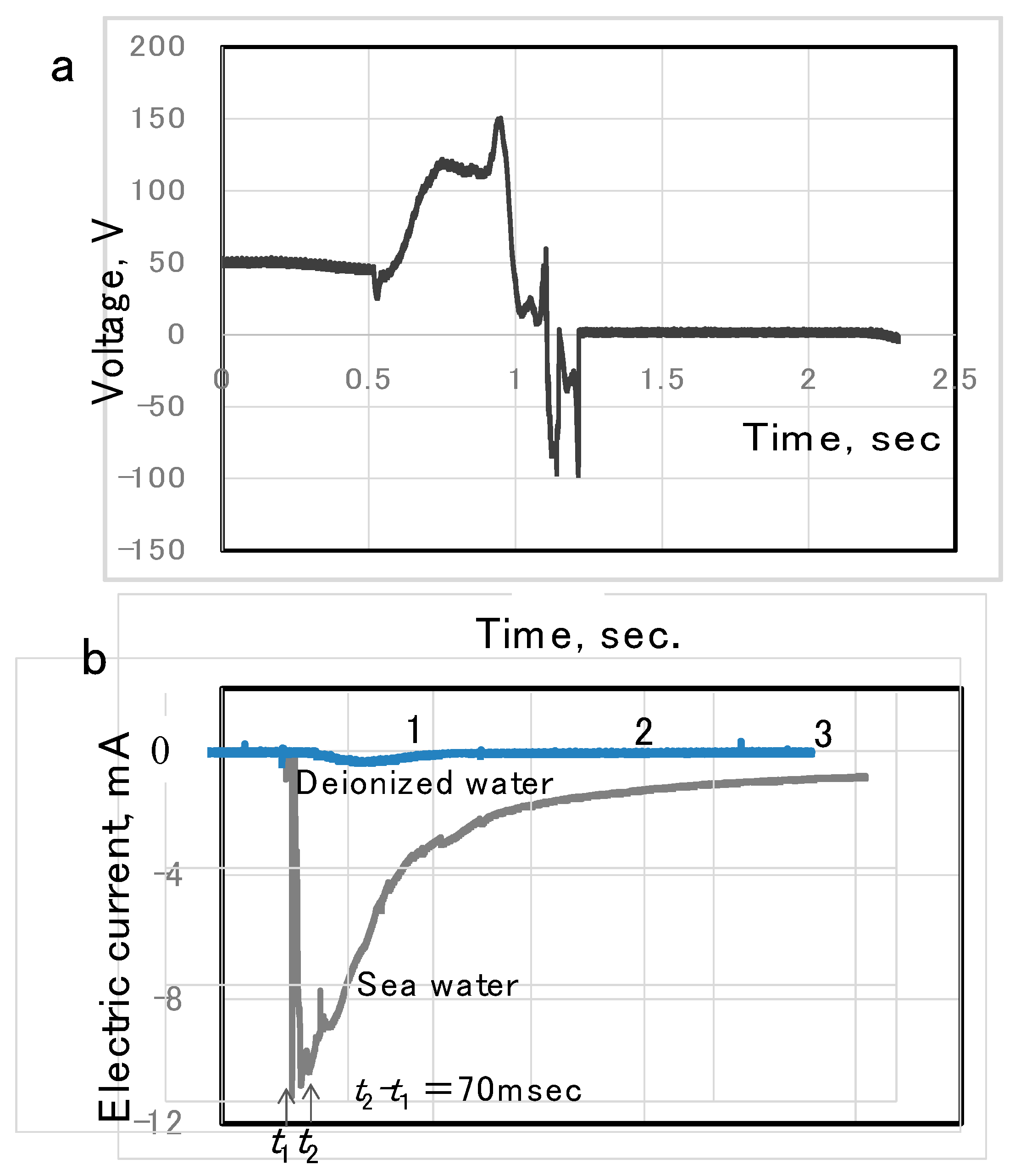

© 2019 by the authors. Licensee MDPI, Basel, Switzerland. This article is an open access article distributed under the terms and conditions of the Creative Commons Attribution (CC BY) license (http://creativecommons.org/licenses/by/4.0/).
Share and Cite
Enomoto, Y.; Yamabe, T.; Sugiura, S.; Kondo, H. Possible Mechanism for the Tsunami-Related Fires That Occurred at Aonae Harbor on Okushiri Island in the 1993 Hokkaido Nansei-Oki Earthquake. Geosciences 2019, 9, 253. https://doi.org/10.3390/geosciences9060253
Enomoto Y, Yamabe T, Sugiura S, Kondo H. Possible Mechanism for the Tsunami-Related Fires That Occurred at Aonae Harbor on Okushiri Island in the 1993 Hokkaido Nansei-Oki Earthquake. Geosciences. 2019; 9(6):253. https://doi.org/10.3390/geosciences9060253
Chicago/Turabian StyleEnomoto, Yuji, Tsuneaki Yamabe, Shigeki Sugiura, and Hitoshi Kondo. 2019. "Possible Mechanism for the Tsunami-Related Fires That Occurred at Aonae Harbor on Okushiri Island in the 1993 Hokkaido Nansei-Oki Earthquake" Geosciences 9, no. 6: 253. https://doi.org/10.3390/geosciences9060253
APA StyleEnomoto, Y., Yamabe, T., Sugiura, S., & Kondo, H. (2019). Possible Mechanism for the Tsunami-Related Fires That Occurred at Aonae Harbor on Okushiri Island in the 1993 Hokkaido Nansei-Oki Earthquake. Geosciences, 9(6), 253. https://doi.org/10.3390/geosciences9060253



